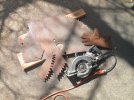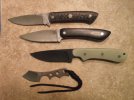- Joined
- Apr 8, 2009
- Messages
- 1,367
I have a buddy who owns a antique shop close to the house. He was these very large saw blades and I was wondering if they were of any value not knowing the steel. I don't do my own heat treating yet as everything is sent off to Peters.
The smaller one is about 2'-6" across and the first in about 4' across. I like the idea of using it I just wanted to know if anyone has experience and if they were made from a known steel.


He also has about 50 misery whip blades.
The smaller one is about 2'-6" across and the first in about 4' across. I like the idea of using it I just wanted to know if anyone has experience and if they were made from a known steel.


He also has about 50 misery whip blades.


